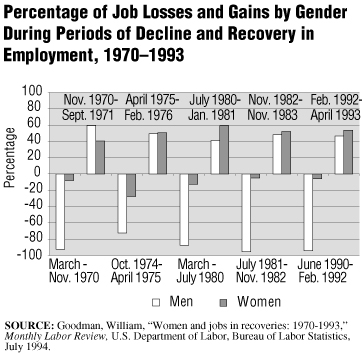
The chart above shows the percentage of job losses and gains by gender and by periods of employment decline and recovery from 1970 to 1993. The data used to create the chart include only non-farm employment. They do not include self-employment.
In every economic recovery since September 1971, women have gained a larger percentage of the newly created jobs than men have, even though men have consistently lost most of the jobs during times of economic downturn.
Most of the jobs lost during the economic downturns have been in industries that are easily affected by the ups and downs of the economy, such as construction and manufacturing. Men, traditionally, have held most of these jobs. On the other hand, many of the jobs that are traditionally held by women continued to grow during the last economic downturn and gained even more during the economic recovery. These jobs include health care occupations, social services, and public school occupations. The following table shows the percentage of men and women in the various industries.
Approximate Percentage of Employment by Gender, 1993
| Industry |
Men (%) |
Women (%) |
| Construction |
90 |
10 |
| Manufacturing |
67 |
33 |
| Health care |
18 |
82 |
| Social services |
22 |
78 |
| Local public schools |
30 |
70 |
In an economic downturn, the goods-producing sector and those industries that deal with that sector, such as retail trade, are the ones that lose the most jobs. Even when there was a recovery, the manufacturing industry still continued to lose jobs. This was due to automation, foreign competition, and cutbacks in government and commercial contracts.
While people are less likely to buy goods during an economic slowdown, there is always a need for health care, social services, and schools. The aging of the population, the increased priority people put on health care, and the added jobs when new treatments are developed all contribute to the increase in health care and social service jobs. During the last recovery, the number of jobs in state and local government also expanded, with much of that growth in the school system.
In conclusion, overall, women are more likely to keep and gain jobs during economic cycles than men due to the types of industries that employ the majority of women. More men are employed in goods-producing industries, which are affected more by economic slowdowns, automation, and foreign competition. More women are employed in service industries and state and local government. These industries do not lose as many jobs during economic downturns and, in recent years, tend to expand the number of jobs both in downturns and recoveries.
SOURCE NOTE–This essay is one from the first volume of a four volume reference work titled Social Trends & Indicators USA, written by the staff of Editorial Code and Data, Inc. and published, in 2003, by Thomson Gale. It is being used here, by Editorial Code and Data, Inc., to do some testing of electronic data presentation.

Looks much better. You’re right about “busy,” but this one communicates.